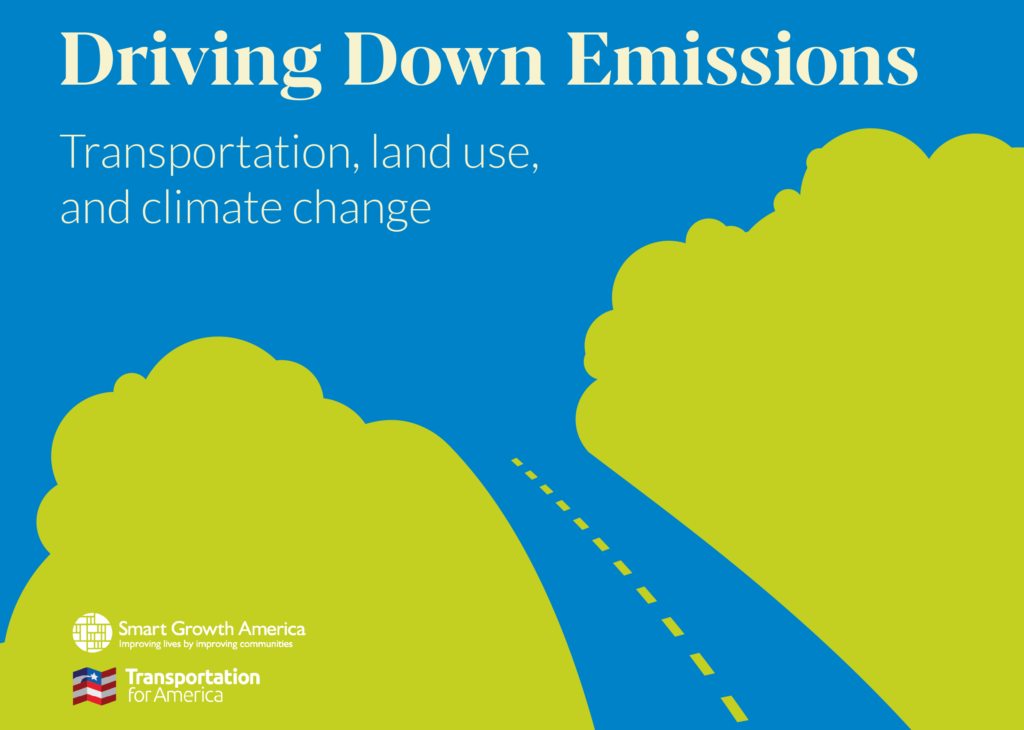We’ll never address climate change without making it possible for people to drive less
With transportation accounting for the largest share of carbon emissions in the U.S., we’ll never achieve ambitious climate targets or create more livable and equitable communities if we don’t find ways to allow people to get around outside of a car—or provide more housing in places where that’s already an option. Our new report shows how we can reach those targets while building a more just and equitable society.

Join us on October 28th for a short online discussion about what’s in Driving Down Emissions. We’ll be walking through the report briefly and sharing some stories about how one state has had some success—and the limitations of electric vehicles. Register here.
It seems like climate-focused policymakers have a single-minded obsession with the silver bullet solution of everyone in America buying a brand new electric car, while ignoring an underlying system that requires everyone to drive further every year, kills people walking in record numbers, and creates communities that cuts people off from jobs and opportunities. Yet the simple truth is that we’ll never achieve our ambitious climate targets or create more livable and equitable communities if we don’t find ways to allow people to get around outside of a car.
We need a different set of solutions to pair with one day being able to convert our current gas-powered vehicle fleet to electricity. Driving Down Emissions, a new report from Transportation for America and Smart Growth America, explores how our land-use and transportation decisions are inextricably connected, and unpacks five strategies that can make a significant dent in the growth of emissions while building a more just and equitable society:
- Getting onerous government regulations out of the way of providing more homes where people naturally drive less;
- Making safety the top priority for street design to encourage walking, biking, and shorter driving trips;
- Instituting GHG reduction and less driving as goals of the transportation system;
- Investing heavily in other options for getting around, and;
- Prioritizing access to destinations.
Reducing transportation emissions and reducing the distance we drive is both needed and possible. The vast majority of Americans are clamoring to spend fewer hours behind the wheel, not more. Only a cynic would declare that Americans want to drive more and more each year to accomplish all they need to do each day. Polling and consumer preference research has consistently shown that millions would prefer to live in walkable, connected places where trips are short and there’s a menu of options for getting around.
Yet that demand is going unmet, and some of the biggest obstacles to meeting it are onerous government regulations and policies (at all levels) that make it nearly impossible to build more housing in places that fit this bill, or to retrofit streets to make more areas safe to walk or bike in. These factors combine to make existing housing in walkable places unaffordable and unattainable.
Let that sink in: millions of Americans would love to live in places that guarantee shorter trips, fewer trips, more ways to get around, and less emissions—whether climate change is their motivating factor or not. But millions can’t find a place they can afford because of zoning requirements that make it either incredibly difficult or downright illegal to meet this demand, and because transportation designs and objectives that make it dangerous to try to get around elsewhere without a car.
If lower-income Americans can’t afford a car then they have no choice but to limit the possibilities for their lives to what can be reached on dangerous streets by foot or bike, or via infrequent buses or trains on underfunded transit systems that fail to connect them to opportunity, even if the emissions are low. Finding ways to put more housing in places where people can drive less—and making those homes attainable and affordable—will be a key aspect of transitioning to a low-carbon economy without placing a new burden on lower-income Americans.
This report shows that reducing emissions from transportation is entirely doable—which is a good thing, because there are other areas where making significant reductions will be far more difficult. While we don’t want to repeat the economic conditions of the COVID-19 pandemic, the massive drops in traffic and emissions during the shutdown showed us the potential benefits of lowering driving rates, even if just a modest amount. And while we have no idea how to completely electrify our fleet of vehicles or how long that transition will even take, we can absolutely lower emissions in a short timeframe by meeting the demand for more housing in smart locations—helping millions of Americans who want to live in places where they can emit less and drive less find ways to do so.
The urgency of our climate crisis requires it.



















